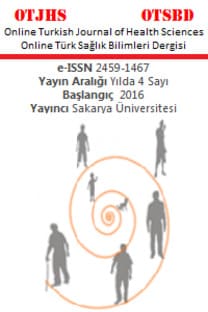Sakarya İlinde Hepatit C Virüs Genotip Dağılımı; Üç Yıllık Retrospektif Çalışma
Hepatit C virüs, genotip dağılımı
Hepatitis C Virus Genotype Distribution in Sakarya Province; Three-Year Retrospective Study
Hepatitis C virus genotype distribution, RNA,
___
- Lauer GM, Walker BD. Hepatitis C virus infection. New England Journal of Medicine. 2001;345(1):41-52.
- Hanafiah KM, Groeger J. Global epidemiology of hepatitis C virus infection: new estimates of age‐specific antibody to HCV seroprevalence. Hepatology. 2013;57(4):1333-42.
- Lozano R, Naghavi M, Foreman K, et al. Global and regional mortality from 235 causes of death for 20 age groups in 1990 and 2010: a systematic analysis for the Global Burden of Disease Study 2010. The Lancet. 2012;380(9859):2095-128.
- Perz JF, Armstrong GL. The contributions of hepatitis B virus and hepatitis C virus infections to cirrhosis and primary liver cancer worldwide. Journal of Hepatology. 2006;45(4):529-38.
- Timm J, Roggendorf M. Sequence diversity of hepatitis C virus: implications for immune control and therapy. World Journal of Gastroenterology: WJG. 2007;13(36):4808.
- Smith DB, Bukh J, Kuiken C, et al. Expanded classification of hepatitis C virus into 7 genotypes and 67 subtypes: updated criteria and genotype assignment web resource. Hepatology. 2014;59(1):318-27.
- Gower E, Estes C. Global epidemiology and genotype distribution of the hepatitis C virus infection. Journal of Hepatology. 2014;61(1):S45-S57.
- Messina JP, Humphreys I, Flaxman A, et al. Global distribution and prevalence of hepatitis C virus genotypes. Hepatology. 2015;61(1):77-87.
- Mıstık R. Hepatit C Virüs enfeksiyonunun epidemiyolojisi. Editörler: Fehmi Tabak, Selma Tosun. Viral Hepatit Kitabı 2014, Viral Hepatitle Savaşım Derneği Yayını, İstanbul tıp Kitabevi 2013, İstanbul 2013; 83-112.
- Yilmaz Sİ, Erol S. Distribution of viral genotypes and extrahepatic manifestations in patients with chronic hepatitis C in Eastern Turkey. Turkish Journal of Medical Sciences. 2015;45(1):70-5.
- Altuglu I, Soyler I. Distribution of hepatitis C virus genotypes in patients with chronic hepatitis C infection in Western Turkey. International Journal of Infectious Diseases. 2008;12(3):239-44.
- Liver EAFTSOT. EASL Clinical Practice Guidelines: management of hepatitis C virus infection. J hepatol. 2011;55:245-64.
- Tüzüner U, Saran Gülcen B, Özdemir M, Feyzioğlu B, Baykan M. Seven-year Genotype Distribution Among Hepatitis C Patients in a City in the Central Anatolia Region of Turkey. Viral Hepat J. 2018;24:12-17.
- Altindis M, Dal T, Akyar I, et al. Six-year distribution pattern of hepatitis C virus in Turkey: a multicentre study. Biotechnology & Biotechnological Equipment. 2016;30(2):335-40.
- Zeytinli ÜO, Yücel FM. Distribution of hepatitis C virus genotypes in the region of Istanbul Northern Anatolian Association of Public Hospitals. Viral Hepatit Dergisis. 2017;23(1):10.
- Kirdar S, Aydin N. Dynamics of HCV epidemiology in Aydin province of Turkey and the associated factors. Apmis. 2018;126(2):109-13.
- Aktas O, Özbek A. Distribution of HCV genotypes in patients of with chronic hepatitis C in the eastern anatolia region. Viral Hepatit Dergisi. 2014;20(3).
- Kayman T, Karakukcu C. Genotypic distribution of hepatitis C virus infection in Kayseri region. J Turk Mikrobiyol Soc. 2012;42:21-6.
- Borcak D, Çagır U. Distribution of hepatitis C virus genotypes and their association with serum alanine aminotransferases and quantitative Serum HCV RNA levels. Journal of Antimicrobial Chemotherapy. 2015;29:36-40.
- Gökahmetoğlu S, Atalay M. Determination of the hepatitis C virus genotypes with'pyrosequencing'method. Erciyes Medical Journal. 2011;33(2):99-102.
- Sağlik İ, Mutlu D, Öngut G, et al. Distribution of hepatitis C virus genotypes among patients with chronic hepatitis C infection in Akdeniz University Hospital, Antalya, Turkey: a five-year evaluation. Mikrobiyoloji bulteni. 2014;48(3):429-37.
- Çekin Y, Gür N. Antalya Eğitim ve Araştırma Hastanesinde kronik Hepatit C hastalarının genotip dağılımının araştırılması. Mikrobiyol Bul. 2014;48(3):484-90.
- Çetin Duran A, Kibar F. Çukurova Üniversitesi Tıp Fakültesi Hastanesi’nde Hepatit C virus genotiplerinin ve HCV enfeksiyonu bulaş yollarının belirlenmesi. Türk Hijyen ve Deneysel Biyoloji Dergisi. 2017;74(3):201-10.
- Agca H. Distribution of Hepatitis C Virus Genotypes in the South Marmara Region. Journal of Clinical and Analytical Medicine. 2014;6(98):190-2.
- ISSN: 2459-1467
- Yayın Aralığı: 4
- Başlangıç: 2016
- Yayıncı: Oğuz KARABAY
Apendiks Tümörlerinin İnsidansı, Tedavisi ve Sağ Kalım: Retrospektif Bir Çalışma
Servet KOCAÖZ, Emin GEMCIOĞLU, Abdurrezzak YILMAZ, Aydan KILIÇARSLAN, Ömer PARLAK
Kas İskelet Sistemi Yakınması Olmayan Osteoartiküler Bruselloz
Ertuğrul GUCLU, Yusuf DURMAZ, Oğuz KARABAY
Çiğdem ÜNAL KANTEKIN, Müge ÇAKIRCA, Ferda YAMAN, Ayşe Yeşim GÖÇMEN
Testis Torsiyonu ile Ortalama Trombosit Hacminin İlişkisi
Almanya'da Yaşayan Türk Göçmenlerin Ruh Sağlığının Değerlendirilmesi
Murat Eren OZEN, Gulumser PELTEK, Mehmet Hamdi ORUM, Aysun KALENDEROGLU, Salih SELEK
Evde Bakım Birimince Takip Edilen Hastaların Bakımlarından Sorumlu Kişilerde Depresyon
Serkan TOKER, Arzu AYRALER, Rahime ÖZGÜR
Akılcı Antibiyotik Kullanımına Uyumda Aile Hekimlerinin Rolü
Ahmet Rıza ŞAHİN, Çiğdem TEKER, Pelin MUTLU AĞAOĞLU, Selçuk NAZİK, Selma ATEŞ
Multipl Skleroz Erken Tanısında Ses Analizi Yönteminin Kullanılabilirliğinin İncelenmesi
Zeynep Zeliha BAYAZIT, Ali Rıza SONKAYA
Huzurevinde Yaşayan Yaşlıların Beslenme Durumları ve Günlük Yaşam Aktivitelerinin Belirlenmesi
